Search the Community
Showing results for tags 'Revell'.
-
Allright, finnished a build yesterday First Timer Modelship wich also can be found here in NoN LSP Works section So now continue with the Maritime theme, Modelkit, well picture needs no presentation, got it second hand on eBay, part sealed in bags. Will use AM this time wich i do not do often at all, so this time go all in with AM, all insignias and markings will be painted, also some scratch. Yes....here it is and here goes. First things first reset the workplace. Nice boxart. Some reference books and all AM that ill use. And the build officially have started
-
It all started innocently enough, for a Cold War airframe. Built in Blackpool in the winter of 1955, when the beaches were empty, but the Hawker Aircraft Blackpool (Ltd) factory was full. She was delivered to the RAF on 10 Jan 1956 as XF 309. Based on the only photographs I can find of her as a pristine F Mk.4, she went to 112 Squadron. You don't have to be an aviation anorak to work this bit out. A typical scene at a Hawker Aircraft factory: churning out Hunters in the mid 1950's 112 Squadron RAF was famous for being the first allied unit to feature a 'sharks mouth'. Even Chennault's 'Flying Tigers' copied them. This is a famous photo of 112 Sqn Tomahawks published in October 1941. No prizes for guessing which squadron XF 309 belongs to... This beautiful airframe was already withdrawn from service by December 1962, and used for ground instruction at St Athan as 7771 M. But don't worry, that's not nearly the end of this tale. While detailing and building the classic Revell kit, we will discover an amazing history in the life of a Hunter, that sees her dressing-up in Yorkshire and being blown-up in Zimbabwe. Let's get down to some plastic first. The kit needs no introduction, so I won't. What is interesting however, is how many of the Hunter builds on the internet stall for some reason or other - it clearly has some issues around the intake and the undercarriage. We'll tackle those when we get there. Not possessing (an increasingly rare) True Details aftermarket cockpit, there is going to be some extra work to get the rather basic cockpit looking a bit more like the real thing. I know its a typical Cold War dark pit, but some extra stuff is always nice. The only cockpit aftermarket I could find was the Kits World 3-D decals for the instrument panel and side consoles. I was most excited to try these, as it is a first for me, and they seem to have revolutionised cockpit detailing. Unfortunately, they didn't enjoy the trip to South Africa. I figured they would look good in the bin, but then thought I'd at least save one or two instrument faces. Some advice - if this happens to you - don't cut, don't throw it away, just treat them like normal decals. I eventually popped them in water and used a bit of white glue to stick them onto thin styrene. Maybe I can still use them? I have copied some ideas from Rockie Yarwood's 'Out of Africa' build, so thanks for pioneering the sidewalls Rockie! Here you can see the rather rudimentary way of using the kit part as a template for cutting ribs. And here the ribs are in situ. It is actually very easy to position them, as the kit is finely marked where the different cockpit components go. Modified the side consoles a bit, however much of the kit detail is useable as is. The stick and rudders really do need some help, as well as the mounting system for the rudder pedals - which would otherwise be pretty much flat on the floor. The gyro gunsight, it would seem, got the most attention! Looking a bit more like the jumbled office a Hunter's cockpit should resemble. Let's see if this one makes it to completion. Cheers, Sean
-
I don't usually do WIPs, but decided for some reason that I'd make the effort with this one, as it's an unusual subject, not least that it's a helicopter in a proper aviation scale. I bought the Revell kit at a show last year for a good price. The kit is in Revell's new box and style, and it was only later I discovered that it was first issued in 1996. This is not a problem, it will just need some work. The box has some colourful options, but I settled on going off-piste and doing a British one. The Army Air Corps bought 16 or thereabouts in the late 1950s/early 1960s to fill a capability gap until the Westland Scout was available. I'll be doing XR385 (c/n 1645) as it appeared at the Middle Wallop Army Air Day in 1975. So on with the show. First the box, illustrating how I deal with those end-opening boxes: cut the top out and tape up the ends. It's a simple kit. Three grey sprues, one clear sprue, instructions, decals, and safety info slip At the moment I can't find any aftermarket for it, any suggestions welcome. (Edit: just found some Eduard Etch - we'll see.) I'll add a set of generic seat belts and some home-cut masks for the markings, otherwise it's from the box all the way. Back later with (hopefully) some actual work accomplished.
- 32 replies
-
Here is my first RFI on the site, proof that I actually have built some models more to come at later stages as I get pics taken. This aircraft is a Bf109G-14/AS from 4./NJG11 (or 5./NJG11 depending on sources). SAM Publications Modellers Datafile "The Messerschmitt Bf109 Part 2 'F' to 'K' variants has an image of the aircraft found in a hangar at the end of the war on page 55 of that book as well as a colour side-view on page 93. Some would have this as possibly a G-6/AS variant, but in my research the presence of the larger Fo987 oil cooler which is quite evident on the image puts this as a G-14/AS, as the G-6's used the smaller Fo870 oil cooler. But hey, I might be totally off the mark! I used the AIMS Decals "Late war 109's" decal sheets as a basis to cut my masks for all the insignia. Parts List: Revell Bf109G-6 "Late and early version" A.M.U.R Reaver Resin cowling and spinner/prop blades Barracuda Studios resin wing inserts, large oil cooler, tall tail wheel, MLG wheels AIMS Late war 109 decals (basis for masks), exhaust stacks, hatches and latches(to modify the filler cap locations for this a/c) HGW Rivet/control surfaces set (for Hasegawa, bit of fettling to make it work on the Revell kit), seatbelts and Bf109 stencil set OWL Fug217 antenna and exhaust stack covers (all now sadly OOP). Some Fug 217 were SB to replace broken parts Master Brass barrels Eduard Instrument panel and Brassin U/C legs Quickboost Revi C/D gunsight MDC Drop tank and centreline mount/braces Noy's Miniatures Luftwaffe Hangar for the photo's All paint/markings/spirals - Gunze Laquers. RLM76 overall Might be a bit more small things I've forgotten about, but hope you all enjoy Thanks for looking Iain
- 28 replies
-
- noys miniatures
- scratchbuilt
- (and 12 more)
-
Inspired by Thunnus amazing 109G-6/AS build earlier this year I've taken a deep breath and started my first advanced conversion build. First cuts and all fits spot on. Reaver prop to go with the conversion = perfect match! Added the Aries radio set for the open hatch at the rear. Designed for the Hasegawa kit it fitted without issue. Cut out the hatch and replaced with the pe. Thinned the inside Aries pit next and a drop in fit. Like Thunnus removed the front bottom pour for the wing strut. Larger oil cooler from Barracuda tested, no problems! Quick dry fit of everything I'd done today. Aaron
- 52 replies
-
- revell
- a m reever
-
(and 7 more)
Tagged with:
-
I’m at the start of a project to convert a 1/32 MDC Typhoon to a car-door type using an abandoned Revell kit as a donor of relevant parts: Ideally I’d like to create a “servicing dio” using this piece of deliciousness: which is the (expensive) CMK Sabre engine designed for a Tempest kit. I know the Tempest had the fuel tank betwixt engine and cockpit: unlike the Tiffie: but “ignoring” that fact, is it feasible to fit it in your knowledgeable opinions gentlemen? In my enthusiasm, am I being blind to any obvious pitfalls or clangers? Any thoughts or observations welcome
-
Whilst I was clearing out my modelling stash for a sell off around IPMS late last year I stumbled across s pile of Revell Hunters - one bought at £29.99 all the rest (6) at £9.99. I actually started work on the first Hunter well over 15 years ago and has since been laid on the shelf of doom after one of our cats knocked it off the table and it broken into pieces. I did rescue the interior and I have now completed some minor repairs to the said cockpit. This was primarily based on the kit cockpit with FlightPath add-on and some resin parts for the sidewalls and ejector seat (I think there might have originally been KMC?). I also added a bunch of tiny details to the cockpit from photographs of F4 and F6 Hunters. I used some of the Flightpath set to add some details to the rather bare wheel bays and some approximate wiring - but nothing like as much in the real aircraft. At the end of the day no-one is going to look underneath anyway :-) Next step is to zip the cockpit up and start on the main assembly and then the various airbrake / flaps from Flightpath - I might even stretch to the gun pack as I have the set. The SU-27 is not dead - just dormant :-)
-
Hello all, Here is my recent Hasegawa/Revell/Hobby 2000 Fw-190 D9 This particular kit is the Revell edition, which comes in a slightly softer plastic the Hasegawa version but still retains the good detail and fit that the original version did....so, no complaints there. This aircraft 'Yellow 10' was Piloted by Major Franz Gotz and was based in Flensburg, Germany in May 1945 and assigned to Stab JG26. All paints used were Gunze Mr Colour and i did most of the markings with masks which saves quite a lot of hassles trying to flatten the decals with the 'ole gloss-sand-gloss-sand routine. The cockpit was done using the Red Fox Studio set to add a better look....not that you can see too much of it but adds to the overall look. As ever, all critique taken and any question are also welcome
- 13 replies
-
- mr colour
- hobby 2000
-
(and 2 more)
Tagged with:
-
Here is Derek Stevenson's Hurribomber (IIB) which in the summer of 1942 was based at Warmwell, near the south coast of Dorset. The props/spinner are by AIMS, the fishtail exhausts by Grey Matters, the parachute by True Details, the wheels by CMK, the outer Browning machine guns by Air Master and most importantly the 250lb bombs and carriers by Tim Perry (ex Flying Start Models)....otherwise OOB! Great kit, very easy pleasant build. Build thread is here. BE687 was lost during the operation code named "Jubilee" attacking the Dieppe area:
-
Greetings all, An Easter holidays completion from me - Revell's 1/32nd scale Hawker Hunter FGA.9 more or less OOB, other than some aftermarket decals from AeroMaster and some home-made FOD guards. This kit is really under-rated in my humble opinion - it has lots of detail OOB and beautiful surface detailing from a time when Revell were at the top of their game. I had no issues whatsoever with the build - it's about as close as you can get to building Lego - and it went together in a few days. Paints were Xtracolur enamels with a splash of Humbrol Matt Cote to finish it off. Some light weathering was done with Mig pastels. All in all a very enjoyable build - and it only cost me a tenner under the table at a show! All the best, Tom Hawker Hunter FGA.9, XG207, 58 Squadron, RAF Wittering, mid-1970s.
-
I’ve always enjoyed building civil aircraft and usually have one or two on the go alongside my longer term LSP builds. So here’s the latest civvy completion from me - Revell’s 1/144th scale Boeing 747-400 with DrawDecal’s British Airways decals. It’s been built out of the box, other than my usual mod to these kits in adding some height on the cockpit crown area with some Milliput to correct the profile. Although it’s getting a little long in the tooth now, the kit still builds reasonably well once excess flash is removed! I was really sad when BA retired the 747 - not only is it one of my favourite commercial aircraft but I’d flown long-haul on them more than any other type and thought I’d do my own little tribute to ‘The Queen of the Skies’. The real thing was my last 747 flight when she brought me back from Australia once… the ‘Kangaroo Route’ is now 777 or 787 and it’s not quite the same. Long live the Queen! All the best, Tom
-
Hello, After having worked for a loooong time on the Revell 1/32 Fw 190 A-8 I needed something else to get my mojo back. The Fw 190 A-8 is almost ready for paint, but when I went over the fuselage rivets again to prepare the surface for painting, the glue joints of the cockpit broke and the cockpit got detached. Fortunately not on all sides so that I can push it up again from the bottom, but that incident vaporized my motivation for a while. So hopefully a fresh start will bring the motivation back. This time it is my favourite WW2 aircraft, the Me 262. I opted for 'White 17' W.Nr. 110958 of III./EJG 2 at Lechfeld for a number of reasons: 1) it is a very well documented bird, 2) there exists a color photo, 3) it had a very interesting camouflage with a nose section that came from a different aircraft (the nose tip appears to be from a 3rd aircraft). The Revell kit has great details out of the box. I wanted to use the kit parts for the cockpit as I don't like Eduard's color printed P/E approach as it is too flat and it depicts a blind flying panel for a very late production variant that had a single-axis auto pilot and required a large repeater compass. Unfortunately, they don't offer resin parts anymore like they did for the Fw 190. The kit part is very good except that instrument layout is that of a early production model and has a cabin pressure gauge that was never installed in serial production aircraft (only in some prototypes or aircraft for testing): Around the end of 1944, there was an effort to simplify the Me 262, the so-called 'Entfeinerung'. It is even mentioned in the cockpit overview of the pilot's manual, but I have also copies of wartime Messerschmitt documents that prove this. Very late production aircraft did not have the two differential pressure and oil pressure indicators anymore, just the fuel gauges and fuel pressure indicators and the two rpm indicator. W.Nr. 110958 was built around January 1945 and still had the differential pressure and oil pressure gauges. There exists immediate postwar footage of the cockpit of W.Nr. 110426 (captured by the Russians) and I own an original immediate postwar photo of the cockpit of W.Nr. 110836 that I use as reference for the required changes: - Remove the cabin pressure gauge (left of the SZKK2 round counter box) - Remove the indicators for the MK 108 underneath the SZKK2, the holes were sometimes left open or covered by a sheet of metall or fabric - Remove the fuel warning indicators (again, the holes were sometimes left open or were covered) - Remove the Junghans watch on the left side of the cabin pressure gauge as they were very rarely installed (in most cases the opening was left open) - The casings of the ASI and rate of climb indicator on the backside are too short and needs to be replaced with longer casings The second thing I wanted to correct was the relatively crude ZSK 244 bomb fusing auxiliary panel that was fitted to almost all the Me 262 As except for the recon versions and the ones (retro)fitted with R4M rockets. The ZSK 244 front plate is quite good, but the panel is flat and doesn't correspond to the original at all. The original had an angle of 15 degrees vs. vertical so that the pilot could better see and operate the instrument. Here are two photos of the original part: I constructed one from scratch using the dimensions of the original and photos as reference. The only part from the kit I used was the front plate of the ZSK 244. I had to carefully sand the kit part to the appropriate thickness. It was a lot of work, but now I am happy with the way the instrument panel looks. Next is painting. Roger
-
Well, let's make it clear I'm not gonna make fuselage longer and wings bigger Also, I have no chance to buy conversion set. This one will be OOB, with resin seat and custom NASA decals As you can see, there is a pile of innacurate plastic and I hope there will be an innacurate model in the end Here are my only AM things At first, I wanted to make a space fighter out of it but this GB convinced me to make it OOB. So I have to bing it back to normal state. I had trouble finding part where parachute is but surprise, surprise it was in scrapbox
-
1/32 AIMS Hurricane PR 1 Hi everyone I thought I would make a start on my AIMS Hurricane PR 1 conversion. I love Monotone finishes mostly because i loath masking but i feel that monotone finishes require a little help and so I try to open at least one hatch or panel. This in turn leads to more work obviously. The wing assemble / gear bay is together and ports filled in - there were a lot of sink holes and badly fitting leading edge parts to fill also. It is a crying shame that Revell produced smooth wings - it is the biggest let down of the kit and expensive to correct as a rivet wheel burring up the plastic surface a little just will not cut it - not in this scale. Pipework and panel locks are a must as a result of the panel being left off which made the Hurricane 'Inside and Out' book a must! Eyes of the Phoenix is also a must read for Hurricane recon operations in the far East and has more PR and Tac R Hurricane photos in it than any other book I am aware of. Finally I have no authority to say that where I have placed the Camera heater selector box is correct - is is purely deductive reasoning based on where the pilot can reach it and where the structure and a lack of other fittings allow. Enjoy John
-
Hi everyone, This is the Revell 1/32 F-4E kit with some aftermarket help from GT Resin in the form of exhausts, belly strap and intakes, new nose from Sierra Hotel, Aim-9Js from Cutting Edge and a cockpit from Legend. The aim was to depict a late 70's USAFE jet from the 50TFW at Hahn AFB using AirDoc decals, put her in-flight and add some lighting to bring her to life. This was sort of a learning project for me, picking up on the excellent tips found in this forum, trying out some new techniques and learning from my mistakes (of which I made a few - see build for details!). In the end it took 2 and a half years to complete so the ratio of builds to acquires is way out of kilter. Anyway, on to the pics... And with lights on... Overall, a challenging but fun build of the impressive Phantom! Build thread is here ... https://forum.largescaleplanes.com/index.php?/topic/58988-132-revell-f-4e-what-could-possibly-go-wrong/&page=1 Many thanks for looking!
-
This is a comparison of the new Revell Fw 190F-8 against the Hasegawa Fw 190F-8 so folks can decide which kit they prefer. Anything questionable was checked against photographs and other information to determine which kit (if either) got it right. Obviously, the full engine and separate control surfaces of the Revell kit are big plusses. And, the low price of the Revell kit in the US makes it hard to pass up. But, not everyone builds their models with everything hanging open. And, elsewhere in the world, the new Revell kit costs almost as much as the Hasegawa. This is not intended to be an in-depth scrutiny of either kit's accuracy. Rather, it is a direct comparison from a modeler's standpoint in an effort to clear up some of the myths, misconceptions and hype already associated with this new kit. Also, these were just the things that I was looking at. Your mileage may differ. If so, please feel free to document it and share it here. The Hasegawa kit's overall accuracy is widely reputed to be quite good, with the notable exceptions of prop, spinner and late upper fuselage gun cover shapes (along with some other, minor things). This is why the Hasegawa kit was chosen as the baseline for checking out the new Revell kit. Overall engineering, shapes and sizes are very similar between the two kits - almost to the point of the parts being interchangeable. Almost. The following images are being posted merely to illustrate the differences between the two kits so that the buyer can make up his/her own mind. Starting at the front: Updated spinner information HERE. Four more posts to come as the spam filter allows...
-
Hi all, Firstly - apologies for not being about much recently - busy with D-Day 70 event/flying exped to Peenemunde/RIAT - followed by the death of one of my flying buddies in a motorcycle accident last Monday. So basically gone from some brilliant experiences - but no time for modelling, to bad week and really not in the mood. To try and break that and put mind on something more positive - I'm going to finally make a start on the new Spit. As one of the many things Tony did in his life was to take the controls of a two seat Spit this one's for you mate! OK - before I wade in - I won't pretend this is in any way definitive - it will include some mods I'll make following reference to photos/drawings/published dimensions/other kits - but my aim is to make a nice looking Spitfire - something I think easily achievable with this kit. What's more - it cost me the princely sum of £18 and I'd hate to waste it! For anyone that followed my He219 build I'd like to keep this thread on a similar - and positive - note throughout. Please chip in if you spot anything - and feel free to throw in discussion points. I really enjoyed building the UHU - and learned a huge amount in the process - but it was very much down to all the help I had from you lot!! EDIT - as I type this I've got two Spits overhead - quite auspicious! So - before I start... Kit fuselage: Top Hasegawa, middle new Revell, bottom Tamiya: Kit with Hasegawa Vb/Revell Hasegawa IIa fuselage (note difference in length from firewall (almost line-up perfectly - to front of cowl - don't ask which is right just yet): Hasegawa Vb/Revell Hasegawa IIa and Tamiya fuselage: Tamiya and Revell IIa fuselage: Comparison has already been made between the Tamiya kit and the new Revell one in Jen's excellent post - nothing further to add. Interesting to note that the nose is quite a lot longer than the Hasegawa Vb - more investigation needed - but otherwise it matches quite closely in profile - if not cross section. Back in a mo... Iain
-
I told you, my resistance is low. A mere week after I received the kit, here are the first pics of my new Hurricane in the making. Following the Revell instructions, I started with the cockpit. It’s a complicated affair as per the original but nonetheless an easy assembly as long as you take care to prepare the parts prior to reaching for the glue. Paints are Gunze , AK and Tamiya lacquers. Stock instrument panel painted with bezel decals added Seat completed. Scratch-built Sutton harness from paper and tin foil Seat installed Harness painted with Vallejo acrylics Gunsight minus reflector glass installed Escape hatch interior Cockpit in situ. Closing the fuselage next. Next time: the wheel wells Thank you for looking and Happy New Year everybody! Cheers, Quang
-
As part of some upcoming large scale, 3D-printed aircraft cockpit upgrade designs, very happy to announce a model of the World War Two-era "Set, Complete Radio 522-A" ("SCR-522-A") used by the US Army Air Corps, Royal Air Force and Royal Australian Air Force. In RAF and RAAF service, this radio set was known as the TR.5043. This model is available in 1/32 and 1/24 scales. Other scales are possible. Often referred to as a "Signal Corps Radio", the SCR-522-A was installed aboard many aircraft types. For example, the SCR-522-A was a conspicuous feature of the P-51D and P-51K Mustang fighters, installed behind the pilot's armored seat back and visible through the bubble canopy. Very soon, we will be releasing a highly detailed, 3D-printed cockpit for the classic Revell 1/32 scale Bristol Beaufighter (see posts below). Click here for the Model Monkey products in 1/24 scale and 1/18 scale Click here for Model Monkey products in 1/32 scale. Click here for the Model Monkey catalog.
- 391 replies
-
- tf mk.x
- tailplanes
- (and 19 more)
-
I am excited to inform you of my forthcoming Hurricane PR set in 1/72, 1/48 and 1/32. The camera fairing is currently being designed but here is a 'first look' at the decal profiles. Hope you see something you like. This is a nice complementary set to go along with my 1/32 PR Spitfire sets in 1/32. I am healing as well as can be expected - a few months and I should be able to cast again. best wishes and thanks for all your support John
-
Hi everyone - I had this set available shortly after the Revell Ju 88 A-1 was released in 2008 but when I recently got the four bladed spinners designed in 3D for the ICM 1/48 kits I asked for them to be also printed in 1/32. As the single decal option on my first ever 1/32 decal sheet had long since been out of print and a whole decal sheet for any 1/32 Ju 88s being currently pointless I decided to get a small amount made and have a small decal / resin part conversion set available at Hannants. So anyway look out for the most straight forward conversion set ever in history haha . I am not expecting a huge reaction to this for obvious reasons (O and yes I see that may should have a capital 'May.') In other news...... My offer of the combined 32D033 'foreign 109's' and the 109 data plates and engine numbers still stands but it seems to have fallen on death ears with only 2 sales and five sales for the data plates on their own. I thought the data plates would be well received with two new 109 kits available in the last month but I was wrong. My JG 54 decals were the most colourful and most expensive I ever got printed by Cartograph - Hannants ordered 20 when they first came out a year or so ago but they have never asked for more so they are just not selling in any of the scales - don't understand it at all? Same goes for the Late War 109 Vol 2 - no reorders after original first order. I continue to try and produce colourful and interesting subjects but seem only to have white elephants? O well it was my choice.
-
'Morning ladies and gents, lads and lassies, Let me give it to you, straight. The Mustang was never one of my favorites. Something to do with the snobbish side of me, never wanting to love a plane everybody loves to love. It's sooo uncool to like a pretty face, right? That is until some months ago, when stranded in a foreign land and estranged from my trusty desk and rusty tools, all that was left for me to do was some virtual modelling on the internet. That is when I read about a new Revell release associated in some way with Radu Brinzan. I knew the name and respected the modeller. I was intrigued and read on, the previews, the reviews, the WIPs ... and soon before long I was hooked. I wrote to my friend in Belgium to buy a kit for me and in anticipation, I myself ordered an Eduard interior set. Thus, months later upon my return to my trusty desk, I was ready to join the fray. For my subject, I chose Art Fiedler's HELEN, a P-51D-5 of the 325 GR in Italy 1944. Seen here in static simulation And in simulated video The main reason for this choice is an opportunity to airbrush the famous yellow-and-black checkers and the various markings using Frisket film. I know it shows my age but what the heck? Secondly, this particular machine is retro-fitted with the dorsal fin fillet DFF found on later versions of the P-51D. So it will give me the chance to try my hand at the controversial 'swayback' fillet as these field-installed mods were known. Just what I needed to spice up an all-too conventional build... or so I thought at that time 'Nuff said. The ride is about to begin, ladies and gentlemen, all aboard. Cheers, Quang
-
Revells cheap kit, quite accurate but in terms of parts quality and fit, overly sliced nose and wings, milky canopy, few steps behind Hasegawa. Added metal landing gear from Eduard, resin propeller, resin beules and exhausts, Eduard interior PE. Insead of riveting whole surface i sprayed dark grey while holding sponge for making "lines" of them and to make surface more 3D then using pecil I created dot here and there. Hartmann as new research tells never scored as many kills as he claimed and never was really first in aces table, but I like non-usual painting schemes and this one really buyed me. Hope you like it!
-
Afternoon all, I thought I'd have a bash as the relatively new Super Bug from Revell. Yes, I've heard all of the horror stories, but it can't be that bad, can it? Work has begun on the main undercarriage bays and engine intake ducting - all given a generous covering of insignia white and a light wash to bring out, what is in my opinion, some lovely and fine detailing: The various formers were added to the bays and the forward and rear bulkheads needed a firm clamping to ensure everything stayed true whilst the glue set: What has become apparent quite early on is the fact that you need to follow the instructions to the letter, as some test fits have shown tolerances are very tight and the slightest misalignment will end in problems... More updates as and when the mood takes. Tom
- 45 replies
-
After a rather lengthy build, this one is finally over the line. I really wanted to do a large scale air superiority blue F-15 and the candy cane scheme of this B model really appealed. As ever, there was no real OOTB version so extras included an Aires early C cockpit, some additional resin parts from Bruce for the rear cockpit, new exhausts from GT Resin, Fuel tanks borrowed from the Revell F-4, modified Aires Aim-7 to get an F variant, CE Aim-9Js a fair bit of scratch built vents etc and of course some added lighting. The Revell kit is OK shape-wise but needs some real love and attention to bring it somewhere near modern standards i.e. no riveting, rather wide panel lines, soft detail etc. Suffice to say I learnt a lot, mostly that I need to be more focused on build Quality from the start rather than fixing up my errors later on! I tried Black basing on this one, but with lots of over-painting which prove more effective, so not sure I'll do it the same way again. The weapons and tanks are attached with magnets so they can be moved around or replaced. I also trialed some acrylic carving for the afterburner effect which turned out quite neat. Anyway, enough words... picture time! And yes the lights still worked (mostly!).... Thanks for looking! And for anyone interested the build thread is below:




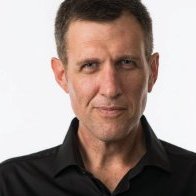




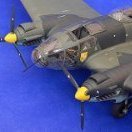

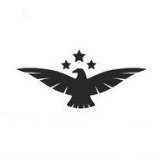


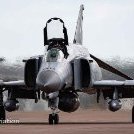

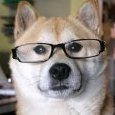

.thumb.jpg.f0920d798d5d8600fb58b1d8a906ddff.jpg)